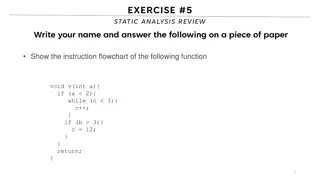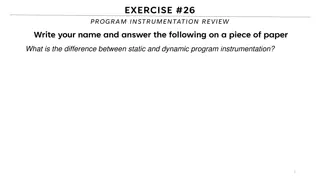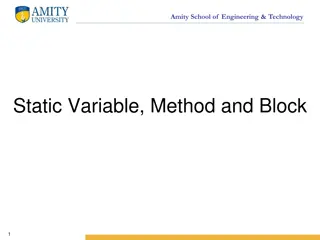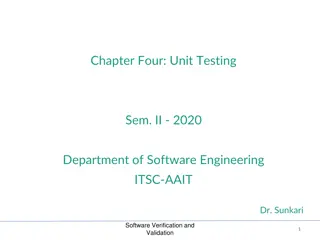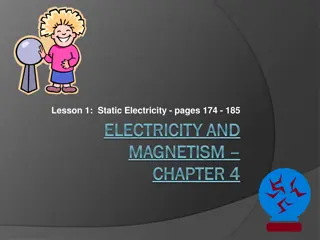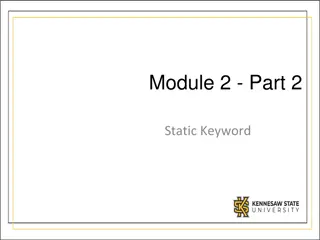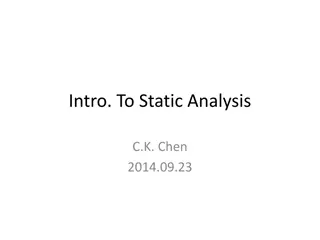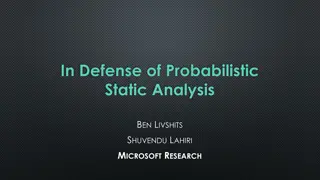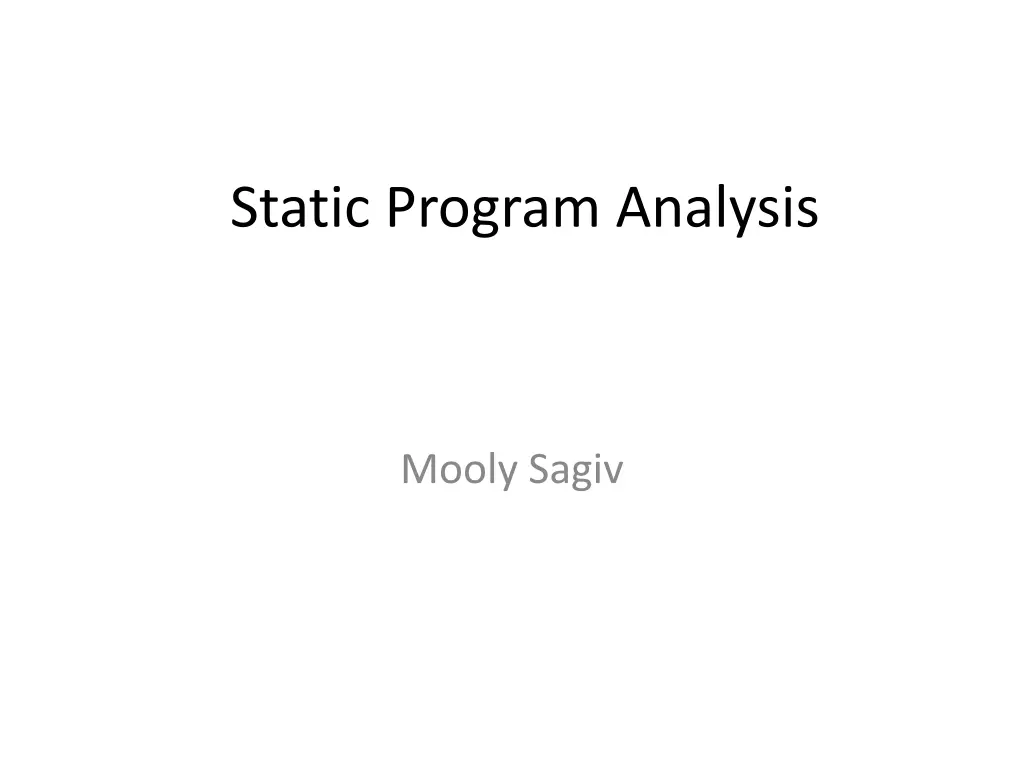
Understanding Static Program Analysis and Soundness
Dive into the world of static program analysis with Mooly Sagiv, focusing on inferring sound invariants and detecting program errors before execution. Learn about both correct and incorrect C code examples along with the challenges of false alarms in static analysis.
Download Presentation

Please find below an Image/Link to download the presentation.
The content on the website is provided AS IS for your information and personal use only. It may not be sold, licensed, or shared on other websites without obtaining consent from the author. If you encounter any issues during the download, it is possible that the publisher has removed the file from their server.
You are allowed to download the files provided on this website for personal or commercial use, subject to the condition that they are used lawfully. All files are the property of their respective owners.
The content on the website is provided AS IS for your information and personal use only. It may not be sold, licensed, or shared on other websites without obtaining consent from the author.
E N D
Presentation Transcript
Static Program Analysis Mooly Sagiv
Static Analysis Automatically infer sound invariants from the code Prove the absence of certain program errors Prove user-defined assertions Report bugs before the program is executed
Simple Correct C code main() { int i = 0, *p =NULL, a[100]; for (i=0 ; i <100, i++) { a[i] = i; p = malloc(1, sizeof(int)); *p = i; free(p); p = NULL; }
Simple Correct C code main() { int i = 0, *p=NULL, a[100]; for (i=0 ; i <100, i++) { { 0 <= i < 100} a[i] = i; { p == NULL:} p = malloc(1, sizeof(int)); { alloc(p) } *p = i; {alloc(p)} free(p); {!alloc(p)} p = NULL; {p==NULL} }
Simple Incorrect C code main() { int i = 0, *p=NULL, a[100], j; for (i=0 ; i <j , i++) { { 0 <= i < j} a[i] = i; p = malloc(1, sizeof(int)); { alloc(p) } p = malloc(1, sizeof(int)); { alloc(p) } free(p); free(p); }
Sound (Incomplete) Static Analysis It is undecidable to prove interesting program properties Focus on sound program analysis When the compiler reports that the program is correct it is indeed correct for every run The compiler may report spurious (false alarms)
A Simple False Alarm int i, *p=NULL; if (i >=5) { p = malloc(1, sizeof(int)); } if (i >=5) { *p = 8; } if (i >=5) { free(p); }
A Complicated False Alarm int i, *p=NULL; if (foo(i)) { p = malloc(1, sizeof(int)); } if (bar(i )) { *p = 8; } if (zoo(i)) { free(p); }
Foundation of Static Analysis Static analysis can be viewed as interpreting the program over an abstract domain Execute the program over larger set of execution paths Guarantee sound results Whenever the analysis reports that an invariant holds it indeed hold
Even/Odd Abstract Interpretation Determine if an integer variable is even or odd at a given program point
Example Program /* x=? */ while (x !=1)do { if(x %2) == 0 assert (x %2 ==0); } } /* x=? */ /* x=? */ { x := x / 2; } else { x := x * 3 + 1; /* x=E */ /* x=O */ /* x=E */ /* x=O*/
A Lattice of values E O ? ? E O E O ?
A Lattice of values E O ? ? E O ? E E E ? ? O O ? O ? E O ? ? ? ? ?
A Lattice of values E O ? ? E O E O ?
A Lattice of values E O ? ? E E E O O O E O ? E O ?
Abstract Interpretation Abstract Concrete Sets of stores Descriptors of sets of stores
Odd/Even Abstract Interpretation All concrete states ? {-2, 1, 5} {x: x Even} {0,2} E O {0} {2}
Odd/Even Abstract Interpretation All concrete states ? {-2, 1, 5} {x: x Even} {0,2} E O {0} {2}
Odd/Even Abstract Interpretation All concrete states ? {-2, 1, 5} {x: x Even} {0,2} E O {0} {2}
Example Program while (x !=1)do { if (x %2) == 0 assert (x %2 ==0); } } { x := x / 2; } else { x := x * 3 + 1; /* x=O */ /* x=E */
(Best) Abstract Transformer Operational Semantics Concrete Representation Concrete Representation St Concretization Abstraction St Abstract Representation Abstract Representation Abstract Semantics
Runtime vs. Static Testing Runtime Static Analysis Effectiveness Missed Errors False alarms Locate rare errors Cost Proportional to program s execution Proportional to program s size No need to efficiently handle rare cases Can handle limited classes of programs and still be useful
Static Analysis Algorithms Generate a system of equations over the abstract values Iteratively compute the least solution to the system The solution is guaranteed to be sound The correctness of the invariants can be conservatively checked
Example Constant Propagation For every variable v and a program point pt, find if v has a constant value every time the program reaches pt
A Simple Example l1: z = 3 l2: x = 1 while (l3: x > 0) { l4: if (x == 1) l5: y = 7 l6: else y = z + 4 l7:x = 3 } l8: label X y z l1 0 0 0 l2 0 0 3 l3 ? ? 3 l4 ? ? 3 l5 ? ? 3 l6 ? ? 3 l7 ? 7 3 l8 ? ? 3
A Lattice of Values (per variable) ? -2 -1 0 1 2
Computing Constants Construct a control flow graph (CFG) Associate transfer functions with control flow graph edges Define a system of equations Compute the simultaneous least fixed point via Chaotic iterations The solution is unique But order of evaluation may affect the number of iterations
A Simple Example l1 l1: z = 3 l2: x = 1 while (l3: x > 0) { l4: if (x == 1) l5: y = 7 l6: else y = z + 4 l7:x = 3 } l8: z = 3 l2 x = 1 x 0 l8 l3 x > 0 x 1 x = 1 l4 x :=3 l5 l6 y = 7 y = z+4 l7
A Simple Example: System of Equations DF[l1] =[x 0, z 0] l1 z = 3 DF[2] =DF[l1] z 3# l2 DF[l4] =DF[l3] x>0#DF[l7] x:=3# x = 1 DF[l3] =DF[l2] x 1# x 0 l8 l3 x =3 DF[l5] =DF[l4] x 1# x > 0 x 1 x = 1 DF[l6] =DF[l4] x=1# l4 DF[l7] =DF[l5] y=7# DF[l6] y=z+4# l5 l6 y = 7 y = z+4 l7 DF[l8] =DF[l]
Chaotic Iterations Chaotic(G(V, E): Graph, s: Node, L: Lattice, : L, f: E (L L) ){ for each v in V to n do dfentry[v] := df[s] = WL = {s} while (WL ) do select and remove an element u WL for each v, such that. (u, v) E do temp = f(e)(dfentry[u]) new := dfentry(v) temp if (new dfentry[v]) then dfentry[v] := new; WL := WL {v}
Solving the system of equations Every solution to the system of equations is sound Non-solution may not be sound Compute a simultaneous least solution iteratively from below Intermediate solutions are not sound
Example Constant Propagation DF(1) = [x 0] DF(2) = DF(1)[x 3] DF(2) 1 x =3 DF(3) = DF(2) 3 2 3t skip skip DF[1] DF[2] DF[3] [x 0] [x 3] [x 3] [x 0] [x ?] [x ?] [x 7] [x 9] [x 7] [x ?] [x 3] [x 3]
A Simple Example: Chaotic Iterations N DF[N] WL {1} 1 [x 0, y 0, z 0] {2} l1 2 [x 0, y 0, z 3] {3} z = 3 3 [x 1, y 0, z 3] {4, 8} l2 4 [x 1, y 0, z 3] {5, 6, 8} x = 1 5 [x 1, y 0, z 3] {6, 7, 8} x 0 6 {7, 8} l8 l3 x =3 7 [x 1, y 7, z 3] {3, 8} x > 0 3 [x , y , z 3] {4, 8} x 1 x = 1 l4 4 [x , y , z 3] {5, 6, 8} 5 [x 1, y , z 3] {6, 7, 8} l5 l6 6 [x , y , z 3] {7, 8} y = 7 y = z+4 7 [x , y 7, z 3] {4, 8} l7 4 {8} 8 [x , y , z 3] {}
When do we loose precision Dynamic vs. Static values Correlated branches Locality of transformers (Join over all path) if ( ) x = 5; y= 7; else x= 7; y = 5; l: z= x + y; Initial value
Example Interval Analysis Find a lower and an upper bound of the value of a single variable Can be generalized to multiple variables
Simple Correct C code main() { int i = 0, a[100]; { [-minint, maxint] } for (i=0 ; i <100, i++) { {[0, 99]} a[i] = i; {[0, 99]} } {[100, 100]}
The Power of Interval Analysis int f(x) { {[minint , maxint]} if (x > 100) { {[101, maxint]} return x -10 ; {[91, maxint-10];} } else { {[minint, 100] } return f(f(x+11)) { [91, 91]} }
Example Program Interval Analysis [x := 1]1 ; while [x 1000]2 do [x := x + 1;]3 [x:=1]1 [x 1000]2 [exit]4 [x := x+1]3
Abstract Interpretation of Atomic Statements skip#[l, u] = [l, u] x := 1#[l, u] = [1, 1] x := x + 1#[l, u] = [l, u] + [1, 1] = [l + 1, u + 1]
Equations Interval Analysis En(1) = [minint,maxint] Ex(1) = [1,1] [x := 1]1 ; while [x 1000]2 do [x := x + 1;]3 In(2) = Ex(1) join Ex(3) Ex(2) = In(2) En(3) = Ex[2] meet [minint, 1000] Ex(3) = In(3)+[1,1] [x:=1]1 [x 1000]2 [exit]4 En(4) =Ex[2] meet [1001, maxint] Ex(4) = In(4) [x := x+1]3
Abstract Interpretation of Joins then else l1 u1 l2 u2 min l1, l2 max u1,u2 [l1, u1] [l2, u2] =[min(l1, l2), max (u1, u2)]
Equations Interval Analysis En(1) = [minint,maxint] Ex(1) = [1,1] [x := 1]1 ; while [x 1000]2 do [x := x + 1;]3 En(2) = En(1) En(3) Ex(2) = En(2) En(3) = Ex(3) = En(3)+[1,1] [x:=1]1 [x 1000]2 [exit]4 En(4) = Ex(4) = En(4) [x := x+1]3
Abstract Interpretation of Meets assume assume l1 u1 l2 u2 max l1, l2 min u1,u2 [l1, u1] [l2, u2] =[max(l1, l2), min (u1, u2)]
Equations Interval Analysis En(1) = [minint, maxint] Ex(1) = [1,1] [x := 1]1 ; while [x 1000]2 do [x := x + 1;]3 En(2) = Ex(1) Ex(3) Ex(2) = En(2) En(3) = Ex(2) [minint,1000] Ex(3) = En(3)+[1,1] [x:=1]1 [x 1000]2 [exit]4 En(4) = Ex(2) [1001,maxint] Ex(4) = En(4) [x := x+1]3
Solving the Equations For programs with loops the equations have many solutions Every solution is sound Compute a minimal solution
An Example with Multiple Solutions [x:=1]1 En(1) = [minint,maxint] Ex(1) = [1,1] [true]2 In(2) = Ex(1) Ex(3) Ex(2) = In(2) IntEntry(3) = IntExit(2) IntExit(3) = IntEntry(3) [skip3 En[1] Ex[1] En[2] Ex[2] En[3] Ex[3] Comments [- , ] [- , ] [- , ] [- , ] [- , ] [- , ] [- , ] [- , ] [1, 1] Maximal [1, 1] [1, 1] [1, 1] [1, 1] [1, 1] Minimal [1, 2] [1, 2] [1, 2] [1, 2] [1, 2] Solution [1, 1] [1, 1] [1, 2] [1, 2] Not a solution
Computing Minimal Solution Initialize the interval at the entry according to program semantics Initialize the rest of the intervals to empty Iterate until no more changes
Iterations Interval Analysis IntEntry(1) = [minint,maxint] IntExit(1) = [1,1] IntEntry(2) = IntExit(1) IntExit(3) IntExit(2) = IntEntry(2) IntEntry(3) = IntExit(2) [minint,1000] IntExit(3) = IntEntry(3)+[1,1] IntEntry(4) = IntExit(2) [1001,maxint] IntExit(4) = IntEntry(4) En[1] Ex[1] En[2] Ex[2] En[3] Ex[3] In[4] Ex[4] [- , ] [1, 1] [1,1] [1,1] [1, 1] [2, 2] [1, 2]
Widening Accelerate the convergence of the iterative procedure by jumping to a more conservative solution Heuristic in nature But simple to implement
Widening for Interval Analysis [c, d] = [c, d] [a, b] [c, d] = [ if a c if b d then a else - , then b else ]


